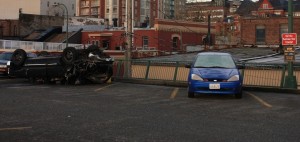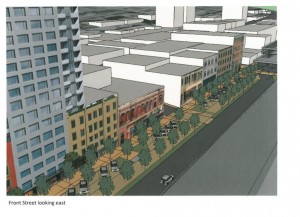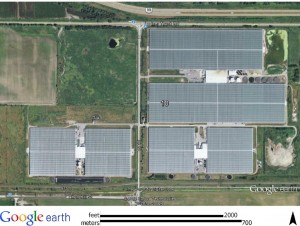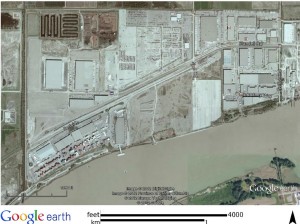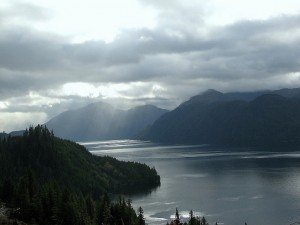As diligent readers are aware (Hi Mom!), I have been ploughing my way through Dr. Patrick Moore’s dissertation on “Sensible Environmentalism”. What started as a review turned into a lengthy criticism. This is the last fit of a 6-part essay, and it is worth reading it all if you want to learn about how Patrick Moore and his Greenwashing company use misinformation, self-contradiction, and frankly absurd ideas to market everything from coal mining to salmon farming as “Green Industries” You can follow these links:
Although this book is full of ideas with which I disagree, and many ideas that are just flat wrong, I always suspected Dr. Moore at the least came by his ideas honestly, or for the most pragmatic reasons. His debatable ideas on clear-cut logging (
the best thing one can do for a forest!) and fish farming (
the only way we could possibly save the native salmon!) likely rise form his history working as a logger and a farmer of fish. His call to end government subsidies for wind and solar, while at the same time making the use of ground-source heat pumps mandatory, may have to do with his promotion to Vice President of
NextEnergy: “the Canadian leader in designing and marketing geothermal systems for the home!”
Or maybe those are coincidences.
However, in his discussion of Anthropogenic Global Warming (AGW), Dr. Moore not only loses his remaining credibility, but loses any claim to being science-minded, skeptical, sensible, or an environmentalist. Coming from someone with the intelligence, training in science, and access to information that Dr. Moore is alleged to have, his arguments are so poorly thought-out, so anti-science, and so ill-informed, that it can only be the result of a disingenuous and callow disregard for the truth, and for the intelligence of his readers. I am going to waste a lot of words discussing this part of the book, because it is a microcosm of everything that is wrong with the current public discourse on AGW.
To get there, we have to first take a step back and talk about Duane Gish. Dr. Gish is a Young-Earth Creationist who met with some small fame holding public debates against scientists on the topic of Evolution. Dr. Gish brought to these his opinion that the Bible is literally true and that the Universe was created in a single 6-day fit about 8,000 years ago, in exactly the order that is written in Genesis. Clearly, this is a preposterous position to debate against a serious scientist with academic expertise in genetics, geology, astronomy, or, for that matter, physics or chemistry. That did not stop Dr. Gish. Paradoxically, audiences would quite often leave the debates feeling Dr. Gish had “won”. This is because he used a rhetorical technique that he wielded with such might and power that it now bears his name.
The Gish Gallop is a debating technique where one uses their allotted time to throw out such a large number of disconnected, unsupported, misrepresented or simply untrue “facts” that the opponent can only hope to refute one or two of them in their rebuttal time. After rebuttal, the Galloper ignores the countering points made by their learned opponent, and just throws out a new random pile of other points, or even the same ones slightly re-phrased, until the opponent is left to throw up their arms in frustration. It is less the shotgun technique than the M61 Vulcan technique.
The point is: for the Galloper, it is not important that you support any of your allegations with truth or data, or even if several of your allegations contradict one another – just keep shooting out stuff and let the poor bastard on the other side try to refute it all. To a general audience, one guy sounds like he has all the facts, the other guy can hardly refute any of them, so guess who wins? The Gish Gallop is well known by Creationist “debaters”, and has been adopted very successfully by people like Lord Monckton when discussing AGW. In skilled hands, it is an effective debating tool. It is also the mark of someone who knows that few of their actual arguments will stand to scrutiny on their own, so in that sense, it is the epitome of being disingenuous.
When I read Dr. Moore’s discussion of AGW, I couldn’t help but see Gish Gallop all over it. He, in turns, argues that it isn’t getting warmer, that warmer is better, that climate scientists lie, that scientists are incompetent, that most scientists don’t believe in AGW, that CO2 cannot cause warming, that the warming caused by CO2 is good for plants, that the ocean is not acidifying, that ocean acidification is good for corals, that human action can’t possibly impact the climate, that human activity might have prevented an ice age, that AGW will lead to more species, that sea level is not rising, that sea level rise is a good thing, that ice is not shrinking, that ice shrinking is a good thing…etc. etc. It is painful to read, mostly because it seems that Dr. Moore forgot that Gish Galloping does not work if those you are debating against have infinite time to refute each point one at a time.
Now I cannot hope to address each of his points here. Even given infinite time and near-infinite bandwidth, my patience to stupidity is not infinite, nor should yours be. So I am going skim the cream off the top of his Gallop, and allow you to find out for yourself if there are any curds below.
Dr. Moore’s discussion of AGW starts by suggesting there is no scientific consensus on AGW. This argument can be summed up into three Logical Fallacies: Argument from Incredulity, Argument from Authority, and Argument from Popularity.
The first argument is basically this:
“The subject of climate change… is perhaps the most complex scientific issue we have ever attempted to resolve. Hundreds, possibly thousands of factors influence the earth’s climate, many in ways we do not fully understand” pg. 330
This is a rather uncompelling argument. I hardly think measuring the basic energy flows of the earth’s atmosphere is all that more complex that, oh, I don’t know, tracking speed-of light particles with half-lives measured in the picoseconds at the Large Hadron Collider or unravelling the 3 billion base pairs in the Human Genome Project. Yeah, complicated, but hardly insurmountable, and with numerous lines of evidence from dozens of different disciplines pointing to the same conclusion, and a well-understood causation train, it is not really that big a scientific leap to conclude that increased CO2 output results in higher atmospheric CO2, which results in a stronger Greenhouse effect.
Argument two sounds like this:
“A comprehensive scientific critique of the IPCC’s findings… was signed by more than 31,000 American scientists and concluded, ‘there is no convincing scientific evidence that human release of…greenhouse gasses is causing or will cause catastrophic heating of the Earth’s atmosphere’. Clearly there is no overwhelming consensus among scientists on the subject of climate.” Pg 332
The 31,000+ name petition of which he writes is none other than the one generated by the venerable climate research foundation the Oregon Institute of Science and Medicine. You need to follow that link to see what they are about, seriously, take a look. It is telling that Dr. Moore talks about their work, and provides lots of references to them in this chapter (more on that later), but he clearly recognized that linking to this source would not improve his credibility. This is what I mean by being disingenuous.
I know, that is a bit of an ad hominem (although, ad hominem is actually a valid rebuttal to Argument from Authority), so lets take a closer look at the 31,000 scientists. You can see from the Petition Project Site that, of the 31,000, exactly 39 self-declared as Climate Scientists. This in comparison to the 2,000+ Climate Scientists who took part in the IPCC Working Group that the Petition Project was a response to. Sounds like something close to a consensus there. What of the other 30,961 scientists? A random mix of biologists, geologists, computer scientists, chemists, engineers and medical doctors. Yes, more than 13,000 were trained in medicine or engineering (I know my podiatrist has strong feelings about Climate Change, but does his M.D. really represent authority on the subject?) The only selection criteria for this Petition Project is that you had to get at least a B.Sc. in some physical science field, or medicine, or engineering. To put that in perspective, there are, according to recent counts, at least 10 Million Americans who have received their B.Sc. in an applicable discipline since 1970. So the 31,000 represent about 0.3% of “American Scientists” the way the petition itself defines them. I dunno, 99.7% sounds pretty close to a consensus to me.
As an aside, they seem to put a lot of emphasis on the scientific credibility of TV weather forecasters. I rest my case.
Ultimately, the Petition Project is a marketing exercise, not a scientific survey. It was a voluntary on-line sign-up, with no vetting of actual credentials. Luckily, a scientific analysis has been done, judging the opinions of climate scientists, other scientists, and the general public. It seems the consensus decreases the less people actually know about the climate and about science. Likely the Dunning-Kruger Effect. Which brings us to Argument #3.
This third argument is a general discussion of how the general public doesn’t believe in AGW. He quotes a bunch of public opinion polls indicating the “man on the street” does not believe in AGW. Or even that people don’t believe that other people believe in AGW, like that is relevant to the scientific certainty of the issue:
“ a poll taken by Ipsos Mori found 60 percent of Britons believed ‘many scientific experts still question if humans are contributing the climate change’. Clearly a majority of the British public does not believe there is a scientific certainty on the subject”. Pg 334.
Now, I hate to sound like a weedy academic elitist, but polling public opinion about the opinions of researchers is not really the best way to find scientific truth.
Do I really need to say that to a guy with a PhD?
Again, for perspective only, I can list things that a majority of Americans think, according to polls similar to the ones Dr. Moore cites, and you can decide if these are, therefore, scientific facts:
80% believe in the literal existence of angels;
78% believe Evolution by Natural Selection is false;
60% believe that Noahs Flood actually happened.
So much for the wisdom of the majority.
Soon after this, Dr. Moore’s honesty takes another dive. There is a bit of intellectual dishonesty that people often engage in, on both sides of this discussion: “cherry picking” data. This is a type of scientific fraud where you pick data that supports your theory, but disregard data that does not, without any justification for that dismissal. Aware of this concern, Dr. Moore says:
”I will try not to ‘trick’ the reader by cherry-picking timelines that support a particular bias” pg336
Then, on the bottom of the very same page he engages in this blatant piece of cherry picking:
”Since 1998 there has been no further warming and apparently a slight cooling” pg336
On… the… very… same… page. He also engages in timeline cherry picking in other areas, such as on Page 344, alleging “cooling” between 1940 and 1980 (when there was actually a slight slowing of the continued warming trend), but let’s concentrate on the first cherry pick, as it is very commonly heard in the Anti-AGW noise.
The grain of truth in that pile of bullshit is that 1998 was previously thought to be the year with the highest average temperature ever recorded by surface-based instruments since reliable instrument records began around the turn of the previous century. It is more commonly held now that 2005 and 2010 were both warmer, with the benefit of more robust analysis. The argument about 1998 vs. 2005 vs. 2010 is kind of irrelevant, though, seeing as how the nine of the hottest years recorded have happened in the last 10 years, with 1998 being the one outlier. Plain and simple: the world is getting hotter at a rate unprecedented in our recorded history, or in the proxy record (Tree rings, varves, coral layers, ice cores, etc.). Surface temperature logs are not the only effect that we measure that demonstrates AGW.
The importance of Rate of Change is a topic that Dr. Moore completely ignores. In 15,000 words on AGW, where he often mentions that the temperature has been warmer in the past (ironically putting trust in scientists who make assumptions about the earths temperature millions of years ago, but not trusting them when they suggest that it is warming now…. cognitive dissonance much?), he never mentions that the rate of temperature change is as important as, if not more important than, the actual amount of change.
This is strange, because Dr. Moore spends a bunch of time talking about how easy it will be for the planet’s species (including people) to react to climate change (after denying it exists). The scientific literature has been pretty clear in demonstrating that adaptation to natural epochal shifts in temperature is a normal part of the world’s ecosystems, but it is the century-scale shifts of multiple degrees that will cause most of the negative ecological effects of AGW. There is no way the boreal forests will have time to shift north if the planet’s temperature increases markedly over less than a century, to give a single example.
Dr. Moore even talks about how the planet was warmer 9,000 years ago by almost 3 degrees during the Holocene Thermal Maximum (which he actually lies about, since the HTM was a regional temperature trend driven by the recession of the Laurentide Ice Sheet, not a global trend, and it was only about 1.6 degrees warmer in areas than today.) but not notice that 3 degrees over 9,000 years is a much different thing than 3 degrees over 100 years. I suspect he is being deliberately obtuse here, or he just hasn’t read the science.
Or maybe he figures the researchers who spend their lives studying historic climates don’t know about the HTM, just like he assumes NASA doesn’t know how to locate or read thermometers. This is the basic accusation he makes against NASA and NOAA. On Page 337 he purports that the Urban Heat Island Effect is causing us to observe increasing temperatures due to local effects only (blithely assuming the scientists at GISS and NASA, who I note are able to put a freaking temperature probe into orbit around Jupiter – haven’t thought about this little detail).
Then on Page 345 he accuses NASA of deliberately removing the “colder” thermometers (an accusation of scientific fraud that has no actual data to support it, and nonetheless has been proven false) to lead to a false conclusion about current temperature trends. He is conveniently avoiding mentioning the myriad of other ways we measure the earth’s temperature aside from the surface thermometer record, such as ocean temperature, satellite observations, and dozens of proxy techniques.
With his scientific credibility tied to Ecology, Dr. Moore, should know more about plants than he is letting on. Perhaps this points to his lack of Masters research, and his apparent lack of academic publishing after his PhD (which was a study on mining policy and local tidal effects). So when he states that the measured increase in atmospheric CO2 is good for plants – and uses some ridiculous horticultural greenhouse studies to support his argument – it is hard to give him the benefit of the doubt and assume he knows not what he thinks.
Dr. Moore (taking cues from other climate change deniers) takes the argument to the most ridiculous extreme on Page 352, suggesting that if human society and the industrial revolution hadn’t come along to produce all of this CO2, then plants probably would have died out from lack of CO2 (wait, didn’t he, few pages earlier, argue that most of the CO2 increase was natural? Yikes).
While it is true that in a hydroponic greenhouse system where there is an infinite supply of all nutrients available to plants, CO2 (which is not plant “food”, but is more plant “air”, to correct the allegory) may become a limiting factor in growth. In this case, adding more CO2 may hasten the growth rate of plants in that very specific, tightly controlled environment. Of course, this translates nada to the real world outside of greenhouses or basement pot farms. The reason for this, as Dr. Moore surely knows, was well understood in the 1800s, when Liebig developed his Law of the Minimum.
Like most biological ideas form the 1800s, this makes perfect sense to even the uneducated in the subject today. Plants require a suite of nutrients to grow: CO2, water, nitrogen, phosphorous, potassium, calcium, etc. Liebig demonstrated, using fertilizers, that their growth is limited by one “limiting nutrient”. That nutrient in nature is usually either water or nitrogen (or, more specifically, the ability of soil bacteria to fix nitrogen). This makes sense to animals too, if you are deprived of water and carbohydrates, no amount of oxygen in the world is going to keep you alive for very long. In reality, increasing atmospheric CO2 enough to dramatically raise atmospheric temperatures will have a negligible effect on plant growth rates, and if it did, it would likely dramatically increase demand for nitrogen in the soil – already the limiting factor for most commercial farming. Even this response is likely to be short-lived and have severe negative repercussions. Don’t take my word for it. And certainly don’t take Dr. Moore’s.
Idiotic is the word that comes to mind when Dr. Moore starts talking about sea ice. He ignores all of the data currently available (on the very website he cites!) that demonstrates that Arctic Sea Ice is continuing to decline in mass, not recovering from 2008 levels as he implies on page 359. He takes one graph from the Cryosphere Today, claiming it shows no reduction in sea ice, yet fails to cite this graph from the same page, or this one, or this one from Antarctica. He also falsely claims that
“Our knowledge of the extent of sea ice in the Arctic and Antarctic began in 1979, the first year satellites were used to photograph the polar regions on a continual basis” Pg 359
This is stunning ignorance. Sea ice was measured by mariners for hundreds of years prior to 1979, and even longer by Inuit. There are also ice cores (which tell us the age of any single piece of sea ice), and dozens of analysis techniques that can be applied to arctic sediments such as varving of sea-floor sediments around arctic deltas, palynology records, arctic flora and fauna growth patterns, and other techniques to trace back the history if ice on both poles. This is another Argument from Personal Astonishment. I don’t know if you noticed, but we know there was ice over Georgia Straight 15,000 years ago, even when we don’t have satellite photos to prove it!
One has to wonder about his ability to do basic journal research when reading his discussion of ocean acidification. On pages 361-362, after quoting a paper by Orr et al that states “Between 1751 and 1994 surface ocean pH is estimated to have decreased from approximately 8.179 to 8.104 (a change of -0.075)”, Dr. Moore replies writing:
”One has to wonder how the pH of the ocean was measured to an accuracy of three decimal places in 1751 when the concept of pH was not introduced until 1909”
Well, one does not have to wonder, because one actually cited the actual freaking scientific paper! All one has to do is read the paper one cited. If one does that, though, one finds the paper cited by Dr. Moore contains no such quote! The quote seems to have been lifted from the esteemed scientific journal Wikipedia, as it appears in the introductory paragraph on the Wikipedia entry on “Ocean Acidification” , although with less precise numbers (which further erodes part of Dr. Moore’s original whinge, doesn’t it?)
Clearly, Dr. Moore didn’t even bother to read the papers he mis-quotes, nor did he bother to read the papers that Wikipedia cited as the source of the quote, because that paper from JGR explains that ocean-atmospheric gas exchange can be very accurately determined if you know the chemistry of the ocean and atmosphere, and a bit about temperatures (all of which can be currently measured from proxies, such as sediment cores, carbon and oxygen isotopes, and coral ring growth). Just because pH hadn’t been discovered, doesn’t mean it didn’t exist. Gravity existed before Newton, you nitwit.
Can we all agree that the days if citing Wikipedia in any discussion about anything other than Wikipedia is irrelevant? It is the internet equivalent of citing the Encyclopaedia Britannica while writing our grade 9 reports on Argentina – the teacher didn’t like it then, and they wouldn’t accept it now. But Dr. Moore cites Wikipedia no less than 12 times during his discussion of AGW.
This crappy citation rigour is, unfortunately, a trend continued during Dr. Moore’s brief Gish Gallop on pages 345-346 to how scientists used to predict a new ice age was coming, providing two excellent references: Spiked Online and something called ZombieBlog. I wonder if their scientists signed the petition.
Yet another argument from Dr. Moores’ personal incredulity is to question if the increases in atmospheric CO2 are actually man made, or just a natural trend; after all, CO2 has been higher in the past.
“Many scientists assume that human emissions of CO2 from burning fossil fuels are the main cause of this [observed] increase [in atmospheric CO2 since 1958]. Some scientists question this assumption.” Pg 336.
This is such an important point of contention, he raises the question rhetorically a few pages later:
”Is CO2, the main cause of global warming, either natural or human-caused?” pg 338
Except this is not an assumption made by scientists, nor is it a rhetorical question, it is an observable phenomenon. Atmospheric scientists can differentiate CO2 from natural and anthropogenic sources, using carbon isotopes . It is pretty clear from isotope analysis that the observed increases in atmospheric CO2 during the 20th century are dominated by fossil fuel burning. If “some scientists question this assumption”, they need to come up with some data to support their point. They haven’t.
There are other topics of scientific illiteracy in this book, but at some point they are coming on so fast and so erratically, that response would be futile. Pure Gish Gallop Gold. Dr. Moore’s profound lack of understanding hydrology leads him to opine that glaciers don’t do anyone any good (Pg357). He suggests a warmer world is better because… wait for it… people like warm weather and can freeze to death when it isn’t warm enough (Pg340). Since wetlands are so good for migratory birds, what’s the problem with rising Sea Levels (pg366)? After a while, throwing this terrible book against the wall was causing me repetitive strain disorders.
Speaking of repetitive strain, Dr. Moore also jumps into “Climategate”. The book first makes a passing reference to this alleged scandal early in his discussion of AGW:
“in November 2009…thousands of emails, leaked or hacked from the Climate Research Unit of the University of East Anglia in the U.K. shocked the climate change community. These revelations were quickly dubbed ‘Climategate’” p337
After a paragraph introducing the topic, Dr. Moore Gish Gallops off to talk about the Copenhagen Conference, causation vs. correlation, polar bears, climate changes over time, etc. for 7 pages, before mentioning “Climategate” again in another stand-alone paragraph
“…the revelations of ‘Climategate’ in November 2009 … clearly showed that many of the most influential climate scientists associated with the IPCC have been manipulating data…”pg 344
There is another drive-by mention a page later, where he at least mentions there were inquiries in to the “scandal” (but fails to mention the scientists were exonerated in all inquiries, and many newspapers were forced to retract their stories previously written about the “scandal”. After no less than 22 pages of random garble on a variety of unrelated topics, Dr. Moore once again raises the topic of “Climategate”, in perfect Gish Gallop technique: if you mention it enough, the words will stick, even if you don’t make a convincing case.
It is actually this fourth mention of “Climategate”, 368 pages into his 390 page book, where Dr. Moore cements the case that he was not interested in the truth. He actually repeats the basest accusations of “Climategate”, the ones that forced reputable newspapers and media outlets to retract the story once they were found to be false. He dismisses the three separate independent inquiries in to the scandal that exonerated the scientists as “whitewashes”. He very clearly did not read the “damning” emails in context, nor did he read the results of the inquiries into the scandal. The only newspaper he cites is the Telegraph of UK, the only one not to retract its “Climategate” reporting.
He also accuses the journals Science and Nature as having “a marked bias in support of human-caused climate change”. It is apparent he is talking about the magazines, but he may as well say the same thing about actual nature (which keeps reacting predictably to a warming planet) and actual science (which keeps finding more evidence of AGW).
Sorry, Dr. Moore. No “Sensible Environmentalist” can continue to ignore both science and nature, and maintain their credibility.
My final review? Don’t read this book. It will make you dumber.
